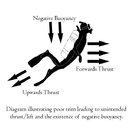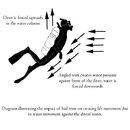Did a little poking around on Gareth's site last night -- there are two VERY good articles on buoyancy control there: DIR Theory
You are using an out of date browser. It may not display this or other websites correctly.
You should upgrade or use an alternative browser.
You should upgrade or use an alternative browser.
Buoyancy techniques
- Thread starter ScubaKeith001
- Start date
Please register or login
Welcome to ScubaBoard, the world's largest scuba diving community. Registration is not required to read the forums, but we encourage you to join. Joining has its benefits and enables you to participate in the discussions.
Benefits of registering include
- Ability to post and comment on topics and discussions.
- A Free photo gallery to share your dive photos with the world.
- You can make this box go away
As others said, there is no substitute for in water time. But there are some other tips. 1) be aware of your buoyancy, and trim it as needed. Check your self whenever you stop- be able to stop and maintain depth with NO MOVEMENT- that means no arms and no kicking; 2) add and remove air from your BC in very small increments; 3) be properly weighted- that means not overweighted and not underweighted either- remember, you will be more buoyant at the end of the dive as air is depleted; 4) zen breathing: maintain a calm and steady breathing pattern; 5) avoid exertion- move calmly, don't chase after stuff; 6) have fun!!!
DivemasterDennis
DivemasterDennis
Last edited:
TS&M touched on an important part of buoyancy control that isn't worked on much--the mental aspects. The physical aspects are easier to describe and demonstrate--the physics of weighting, propulsion and breath control have an objective sort of logic to them. But without the mental aspects, understanding the physics may not help as much as we would like. There are several elements to the mental aspects:
1) Relaxation has been mentioned. This is important because stress makes your muscles tense up, including your ribcage muscles, and breath control is quite difficult when those muscles are tight.
2) Body awareness is another mental aspect. Pay attention to how it feels when you "get it right" even if it's for a brief time--notice your position in the water, how your thighs are angled in relation to your hips and knees, where your hands and arms are, and how your head and neck are positioned. Help your body develop a sort of muscle memory by being consciously aware of it.
3) Visualization is a third mental aspect. Pick a diver you'd like to look like in the water and imagine yourself with the posture and seemingly effortless control that diver exhibits. You might be surprised at how effective this can be.
1) Relaxation has been mentioned. This is important because stress makes your muscles tense up, including your ribcage muscles, and breath control is quite difficult when those muscles are tight.
2) Body awareness is another mental aspect. Pay attention to how it feels when you "get it right" even if it's for a brief time--notice your position in the water, how your thighs are angled in relation to your hips and knees, where your hands and arms are, and how your head and neck are positioned. Help your body develop a sort of muscle memory by being consciously aware of it.
3) Visualization is a third mental aspect. Pick a diver you'd like to look like in the water and imagine yourself with the posture and seemingly effortless control that diver exhibits. You might be surprised at how effective this can be.
ScubaKeith001
Registered
These are all great ideas and I will be trying them on my next dive. My recent dive today I thought I had better control, more relaxed and not fighting the current so much. I will also have my girl video me to see where my tank is at on my BCD and maybe loose another two pounds. Will try it all....
Seems to me that most divers have WINGS and this helps out a lot on buoyancy??? Is this true??
Thanks again for the great responses from everyone!!!
Seems to me that most divers have WINGS and this helps out a lot on buoyancy??? Is this true??
Thanks again for the great responses from everyone!!!
elan
Contributor
No wings do not help with the buoyancy, they might help with the trim a bit but with a single tank is negligible. If you dive a drysuit or a thin wetsuit you should probably have no more than 3 lb worth of lift in gas in your bc. This is very little and I never felt any difference between a wing and a bc.
fisheater
Contributor
Thanks for wanting to be a better diver!!!
I just returned from some vacation diving in Kauai and am still astonished by the downright bad diving I witnessed. Little attention to buoyancy. Dog
paddling. Kicking the heck out of the reefs and leaving silt trails.
And this wasn't from newbies trying to improve. It was from "experienced" divers who simply don't care about getting any better.
Bravo to the OP!
Sent from my iPhone using Tapatalk
I just returned from some vacation diving in Kauai and am still astonished by the downright bad diving I witnessed. Little attention to buoyancy. Dog
paddling. Kicking the heck out of the reefs and leaving silt trails.
And this wasn't from newbies trying to improve. It was from "experienced" divers who simply don't care about getting any better.
Bravo to the OP!
Sent from my iPhone using Tapatalk
"Wings" are just another kind of BC. Almost everybody, except some of the really dedicated vintage divers, dives with some sort of BC. Wings are just air bladders that attach to a plate you wear, as opposed to the BCs that integrate their air bladders into a ready-made whole.
Some BCs make it pretty easy to get balanced, by offering you a lot of attachment points for weights. Others don't. But a properly weighted diver, with a little thought and effort, can almost always balance himself in any BC. (I do my pool dives in a little black and pink jacket BC, and I trim out fine -- took a little work, but it was a problem with a solution!)
This is so, so true . . . on my 20th dive, I dove with NW Grateful Diver. I took one look at him in the water, and said, "I want to dive like that." I immediately began to try to model what he was doing, to the best of my ability. I was amazed to see photographs of me on my next dive trip that showed I was horizontal and flat! Since then, I have seen OW students in the POOL who modeled MY diving, and did a credible job of it. That's why I recommend watching the 5thD-x videos on YouTube; put those pictures in your head, and then imagine yourself diving that way, when you are in the water. Mental pictures have power.
Some BCs make it pretty easy to get balanced, by offering you a lot of attachment points for weights. Others don't. But a properly weighted diver, with a little thought and effort, can almost always balance himself in any BC. (I do my pool dives in a little black and pink jacket BC, and I trim out fine -- took a little work, but it was a problem with a solution!)
3) Visualization is a third mental aspect. Pick a diver you'd like to look like in the water and imagine yourself with the posture and seemingly effortless control that diver exhibits. You might be surprised at how effective this can be.
This is so, so true . . . on my 20th dive, I dove with NW Grateful Diver. I took one look at him in the water, and said, "I want to dive like that." I immediately began to try to model what he was doing, to the best of my ability. I was amazed to see photographs of me on my next dive trip that showed I was horizontal and flat! Since then, I have seen OW students in the POOL who modeled MY diving, and did a credible job of it. That's why I recommend watching the 5thD-x videos on YouTube; put those pictures in your head, and then imagine yourself diving that way, when you are in the water. Mental pictures have power.
Mr Carcharodon
Contributor
Here's a nice article: Buoyancy Control - Tips | DIR Theory
eelnoraa
Contributor
There are certainly a lot of great information here. But certainly, find a mentor. It could be an experience diver, dive with him/her, as him/her for advice. Or better, find a good instructor around you for some private lesson. Persoanlly, I highly recomment GUE fundie, or for that matter, UTD essential type of class. It will have great impacts on all you diving aspects.
DevonDiver
N/A
No wings do not help with the buoyancy, they might help with the trim a bit but with a single tank is negligible.
I disagree. Bad trim plays a direct role in incorrect buoyancy.
If the diver is swimming with a 'head up/feet down' attitude, then their propulsion/thrust will be compensating for buoyancy. Depending on the angle of bad trim, a corresponding proportion of thrust is directed downwards. This means less effficient forward motion, but also serves to propel the diver upwards in the water column. This, in turn, leads to three issues:
(1) The diver will believe that they need more weight to compensate for excessive and unexplained 'buoyancy'.
(2) The diver will have less air in their BCD than necessary, because their fining is providing upwards thrust (interpreted as 'buoyancy').
(3) Any time they cease fining, they will sink, because they aren't actualy neutrally buoyant.
(4) If the diver is actually neutrally buoyant, they will rise in the water when they start fining.
You cannot achieve proper buoyancy control, unless you have good trim in the first place. It is the foundation and needs to be in place.


Similar threads
- Replies
- 5
- Views
- 533
- Replies
- 31
- Views
- 4,865



